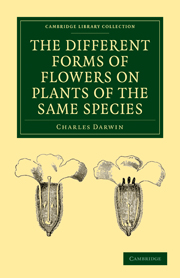Book contents
- Frontmatter
- Contents
- INTRODUCTION
- CHAPTER I HETEROSTYLED DIMORPHIC PLANTS: PRIMTULACEÆ
- CHAPTER II HYBRID PRIMULAS
- CHAPTER III HETEROSTYLED DIMORPHIC PLANTS–continued.
- CHAPTER IV HETEROSTYLED TRIMORPHIC PLANTS
- CHAPTER V ILLEGITIMATE OFFSPRING OF HETEROSTYLED PLANTS
- CHAPTER VI CONCLUDING REMARKS ON HETEROSTYLED PLANTS
- CHAPTER VII POLYGAMOUS, DIŒCTOUS, AND GYNO-DIŒCIOUS PLANTS
- CHAPTER VIII CLEISTOGAMIO FLOWERS
- INDEX
CHAPTER I - HETEROSTYLED DIMORPHIC PLANTS: PRIMTULACEÆ
Published online by Cambridge University Press: 05 July 2011
- Frontmatter
- Contents
- INTRODUCTION
- CHAPTER I HETEROSTYLED DIMORPHIC PLANTS: PRIMTULACEÆ
- CHAPTER II HYBRID PRIMULAS
- CHAPTER III HETEROSTYLED DIMORPHIC PLANTS–continued.
- CHAPTER IV HETEROSTYLED TRIMORPHIC PLANTS
- CHAPTER V ILLEGITIMATE OFFSPRING OF HETEROSTYLED PLANTS
- CHAPTER VI CONCLUDING REMARKS ON HETEROSTYLED PLANTS
- CHAPTER VII POLYGAMOUS, DIŒCTOUS, AND GYNO-DIŒCIOUS PLANTS
- CHAPTER VIII CLEISTOGAMIO FLOWERS
- INDEX
Summary
It has long been known to botanists that the common Cowslip (Primula veris, Brit. Flora, var. officinalis, Lin.) exists under two forms, about equally numerous, which obviously differ from each other in the length of their pistils and stamens. This difference has hitherto been looked at as a case of mere variability, but this view, as we shall presently see, is far from the true one. Florists who cultivate the Polyanthus and Auricula have long been aware of the two kinds of flowers, and they call the plants which display the globular stigma at the mouth of the corolla, “pin-headed” or “pin-eyed,” and those which display the anthers, “thrum-eyed.” I will designate the two forms as the long-styled and short-styled.
The pistil in the long-styled form is almost exactly twice as long as that of the short-styled. The stigma stands in the mouth of the corolla or projects just above it, and is thus externally visible. It stands high above the anthers, which are situated halfway down the tube and cannot be easily seen. In the short-styled form the anthers are attached near the mouth of the tube, and therefore stand above the stigma, which is seated in about the middle of the tubular corolla. The corolla itself is of a different shape in the two forms; the throat or expanded portion above the attachment of the anthers being much longer in the long-styled than in the short-styled form.
- Type
- Chapter
- Information
- Publisher: Cambridge University PressPrint publication year: 2010First published in: 1877



